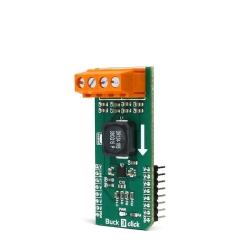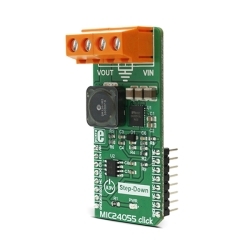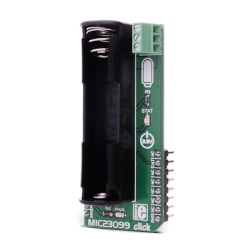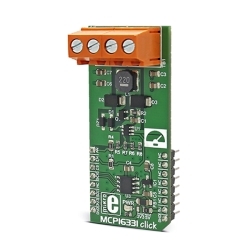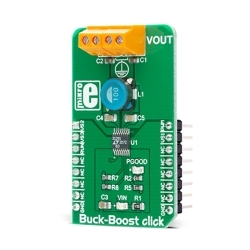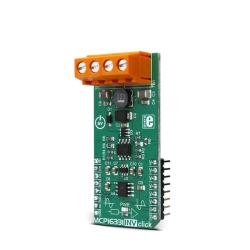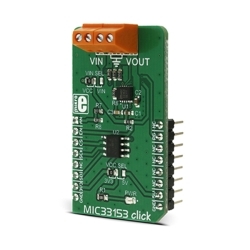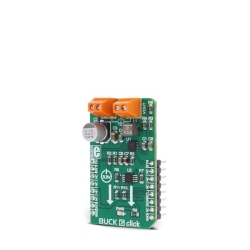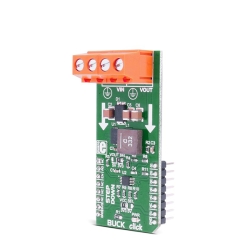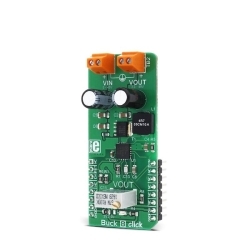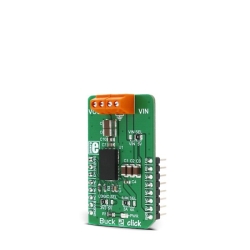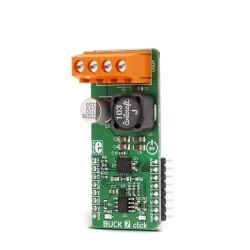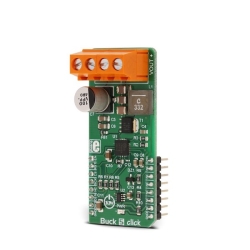MIKROE Buck 3 Click
Buck 3 Click uses the TPS568215, a 4.5V to 17V Input, 8A synchronous step-down SWIFT™ converter from Texas Instruments.
Product Overview
Buck 3 Click is a very advanced synchronous step-down (buck) converter, which is designed to deliver noise and ripple-free voltage to highly sensitive applications, such as FPGA and high-performance DSP platforms. The onboard step-down converter IC integrates low RDSON MOSFETs, that allow high efficiency, and thus high current on the output - up to 8A. Buck 3 operates at 800kHz, allowing an optimal balance between the efficiency and the size of the used components. DCM mode ensures that the efficiency is maintained even while working with light loads.
Besides clean, noiseless and ripple-free 3.3V output provided by the proprietary D-CAP3™ PWM control mode for a fast transient response, this device also features overvoltage and undervoltage protection, thermal protection, current limiting, soft start function, and more. These features allow Buck 3 Click to be used in a range of different applications, such as servers and storage devices, set-top boxes, telecom and networking, sensitive DSP and FPGA embedded applications, and similar applications that require a clean and regulated power supply.
Buck 3 Click uses the TPS568215, a 4.5V to 17V Input, 8A synchronous step-down SWIFT™ converter from Texas Instruments. Its main features are the unparalleled ripple and noise-free operation, as well as the high efficiency throughout the whole load range, up to 8A. As such, it is suitable for powering up power demanding applications. Driven by the D-CAP3™ technology, the TPS568215 allows for a very low number of external components, maintaining an accurate voltage at the output. To further minimize the noise, the TPS568215 has separate grounds for the logic signal and the analog signal. The design of the Click board™ PCB ensures that the low noise operation is maintained within the specifications.
The onboard voltage divider connected to the MODE pin of the IC is used to set the device to work with the fixed PWM frequency of 800kHz, DCM/Eco-mode™ for light loads, and to set the limiting current to about 7A.
When the connected load is light enough, the ripple current valleys on the inductor coils will cross zero. Since the TPS568215 is set to operate in DCM/Eco-mode™, the device will start skipping PWM pulses, maintaining the efficiency that way. For regular loads, the device will be operated with the fixed frequency PWM signal, set by the MODE pin - 800kHz, providing low ripple and low noise output voltage.
The PGD (power good) pin is used to signalize the undervoltage or overvoltage status of the device. When the voltage on the feedback pin is between 97% and 107% of the nominal output voltage, this pin is de-asserted and pulled to a HIGH logic level by the onboard pull-up resistor. When a faulty condition occurs, this pin is driven to a LOW logic state. PGD pin is routed to the CS pin of the mikroBUS™
The EN pin is used to enable the device. Setting this pin to HIGH logic level (above 1.2V) will activate the internal switching circuitry. When the pin is set to a LOW logic level, the device is in STANDBY mode, and the power consumption is minimal. The EN pin is routed to the mikroBUS™ AN pin.
This Click board™ is not powered up by the mikroBUS™ power rails. The power for the logic sections of the IC is supplied by the internal LDO output from the TPS568215 (VREG). This internal LDO is supplied by the input voltage, so the Buck 3 Click will appear unpowered unless the external power supply is connected to the input terminal.
Buck 3 Click has two 2-pole terminals, used to connect the external power supply and the load. These robust input and output screw terminals have cross-section dimensions which allow high currents to be connected, with no heating or damage.
Features & Specs
- Interface: GPIO
- Compatibility: mikroBUS™
- Dimensions: 57.15 x 25.4mm
- Input Voltage: External
- Input Voltage (External): Min. -0.3V, Max. 10V
- Regulated Output Voltage: 3.3V
- Current Output: 8A
Documentation
Customer Reviews
